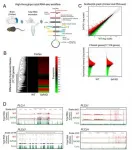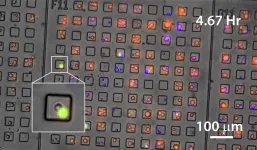(Press-News.org) Red supergiants are a class of star that end their lives in supernova explosions. Their lifecycles are not fully understood, partly due to difficulties in measuring their temperatures. For the first time, astronomers develop an accurate method to determine the surface temperatures of red supergiants.
Stars come in a wide range of sizes, masses and compositions. Our sun is considered a relatively small specimen, especially when compared to something like Betelgeuse which is known as a red supergiant. Red supergiants are stars over nine times the mass of our sun, and all this mass means that when they die they do so with extreme ferocity in an enormous explosion known as a supernova, in particular what is known as a Type-II supernova.
Type II supernovae seed the cosmos with elements essential for life; therefore, researchers are keen to know more about them. At present there is no way to accurately predict supernova explosions. One piece of this puzzle lies in understanding the nature of the red supergiants that precede supernovae.
Despite the fact red supergiants are extremely bright and visible at great distances, it is difficult to ascertain important properties about them, including their temperatures. This is due to the complicated structures of their upper atmospheres which leads to inconsistencies of temperature measurements that might work with other kinds of stars.
"In order to measure the temperature of red supergiants, we needed to find a visible, or spectral, property that was not affected by their complex upper atmospheres," said graduate student Daisuke Taniguchi from the Department of Astronomy at the University of Tokyo. "Chemical signatures known as absorption lines were the ideal candidates, but there was no single line that revealed the temperature alone. However, by looking at the ratio of two different but related lines -- those of iron -- we found the ratio itself related to temperature. And it did so in a consistent and predictable way."
Taniguchi and his team observed candidate stars with an instrument called WINERED which attaches to telescopes in order to measure spectral properties of distant objects. They measured the iron absorption lines and calculated the ratios to estimate the stars' respective temperatures. By combining these temperatures with accurate distance measurements obtained by the European Space Agency's Gaia space observatory, the researchers calculated the stars luminosity, or power, and found their results consistent with theory.
"We still have much to learn about supernovae and related objects and phenomena, but I think this research will help astronomers fill in some of the blanks," said Taniguchi. "The giant star Betelgeuse (on Orion's shoulder) could go supernova in our lifetimes; in 2019 and 2020 it dimmed unexpectedly. It would be fascinating if we were able to predict if and when it might go supernova. I hope our new technique contributes to this endeavor and more."
INFORMATION:
Journal article
Daisuke Taniguchi, Noriyuki Matsunaga, Mingjie Jian, Naoto Kobayashi, Kei Fukue, Satoshi Hamano, Yuji Ikeda, Hideyo Kawakita, Sohei Kondo, Shogo Otsubo, Hiroaki Sameshima, Keiichi Takenaka and Chikako Yasui. Effective temperatures of red supergiants estimated from line-depth ratios of iron lines in the YJ bands, 0.97-1.32 μm. Monthly Notices of the Royal Astronomical Society.
DOI: 10.1093/mnras/staa3855.
http://doi.org/10.1093/mnras/staa3855
Funding
The WINERED was developed by the University of Tokyo and the Laboratory of Infrared High-resolution spectroscopy (LiH), Kyoto Sangyo University under the financial supports of Grants-in-Aid, KAKENHI, from Japan Society for the Promotion of Science (JSPS; Nos. 16684001, 20340042, and 21840052) and the MEXT Supported Program for the Strategic Research Foundation at Private Universities (Nos. S0801061 and S1411028). This work has been supported by Masason Foundation. DT acknowledges financial support from Toyota/Dwango AI scholarship and Iwadare Scholarship Foundation in 2020. NM, NK and HK
acknowledge financial support of KAKENHI No. 18H01248. NK also acknowledges support through the Japan-India Science Cooperative Program between 2013 and 2018 under agreement between the JSPS and the Department of Science and Technology (DST) in India. KF acknowledges financial support of KAKENHI No. 16H07323. HS acknowledges financial support of KAKENHI No. 19K03917.
Useful links
Department of Astronomy - http://www.astron.s.u-tokyo.ac.jp/en/index.html.en
Institute of Astronomy - http://www.ioa.s.u-tokyo.ac.jp/en/
Graduate School of Science - https://www.s.u-tokyo.ac.jp/en/index.html
Research contact
Daisuke Taniguchi
Department of Astronomy, Graduate School of Science, The University of Tokyo,
7-3-1 Hongo, Bunkyo-ku, Tokyo 113-0033, JAPAN
Tel: +81(0)3-5841-4268
Email: taniguchi@astron.s.u-tokyo.ac.jp
Press Contact
Mr. Rohan Mehra
Division for Strategic Public Relations, The University of Tokyo
7-3-1 Hongo, Bunkyo-ku, Tokyo 113-8654, JAPAN
Email: press-releases.adm@gs.mail.u-tokyo.ac.jp
About the University of Tokyo
The University of Tokyo is Japan's leading university and one of the world's top research universities. The vast research output of some 6,000 researchers is published in the world's top journals across the arts and sciences. Our vibrant student body of around 15,000 undergraduate and 15,000 graduate students includes over 4,000 international students. Find out more at http://www.u-tokyo.ac.jp/en/ or follow us on Twitter at @UTokyo_News_en.
Tokyo, Japan - Researchers from Tokyo Metropolitan University have revealed how liquid foams collapse by observing individual collapse "events" with high-speed video microscopy. They found that cracks in films led to a receding liquid front which sweeps up the original film border, inverts its shape, and releases a droplet which hits and breaks other films. Their observations and physical model provide key insights into how to make foams more or less resistant to collapse.
Understanding how foams collapse is serious business. Whether it's ensuring fire extinguishing foams stay long enough to put out flames, cleaning up toxic foams in seas and rivers, or simply getting the perfect rise on a cake, getting to grips with how foam materials collapse is vital to tailoring their properties, ...
Korea Brain Research Institute (KBRI, President Suh Pann-ghill) announced that the research team led by Dr. Jae-Yeol Joo discovered new cryptic splice variants and SNVs in PLCg1 gene of AD-specific models for the first time using Splice-AI.
This research outcome was published in PNAS, a world-renowned academic journal.
* (Title) Prediction of Alzheimer's Disease-Specific phospholipase c gamma-1 SNV by Deep Learning-Based Approach for High-Throughput Screening
Alternative splicing variant regulates gene expression and influences diverse phenotypes. Especially, genetic ...
Marine protected areas (MPAs) around O?ahu do not adequately protect populations of herbivorous reef fishes that eat algae on coral reefs. That is the primary conclusion of a study published in Coral Reefs by researchers from the University of Hawai?i at Mānoa School of Ocean and Earth Science and Technology (SOEST).
There are over 20 species of herbivorous fishes and ten species of herbivorous urchins commonly observed on Hawaiian reefs. These species eat algae that grows on reefs, a process called herbivory, that contributes to the resilience of coral reefs by preventing algae dominance that can lead to overgrowth of corals.
The team of researchers found that of the four marine protected areas around O?ahu they assessed in the study, ...
The ability to read is foundational to education, but prolonged school closures and distance learning due to the pandemic have imposed unique challenges on the teaching of many fundamental skills. When in-person classes resume, many students will likely need a period of catch-up learning, especially those who lag behind in basic reading skills.
New research published in the journal Psychological Science shows that people who were taught to read by receiving explicit instructions on the relationship between sounds and spelling experienced a dramatic improvement compared to learners who discovered this relationship naturally through the reading process. These results contribute to an ongoing debate about how best to teach children to ...
New research from Baylor College of Medicine scientists shows that a combination of deep brain stimulation (DBS) and exercise has potential benefits for treating ataxia, a rare genetic neurodegenerative disease characterized by progressive irreversible problems with movement.
Working with a mouse model of the human condition, researchers at Baylor and the Jan and Dan Duncan Neurological Research Institute at Texas Children's Hospital discovered that combining DBS targeted to the cerebellum, a major motor center in the brain, and exercise rescued limb coordination and stepping and that the benefits persisted without further stimulation. In addition, the study reports that stimulating mice with early-stage ataxia showed the most dramatic improvements. These and other ...
BOSTON -- Billions of peripheral white blood cells are produced every day by the regular divisions of hematopoietic stem cells and their descendants in the bone marrow. Under normal circumstances, thousands of stem cells contribute progeny to the blood at any given time, making white blood cells a group with diverse ancestry.
Clonal hematopoiesis is a common age-related condition in which the descendants of one of these hematopoietic stem cells begin to dominate substantial portions of the blood. Genome-wide analyses have determined that clonal ...
COLUMBIA, Mo. - While physical activity is important for everyone, research has shown people with developmental disabilities do not exercise as often as their typically developed peers. In an effort to close this disparity, a researcher at the University of Missouri recently created fitness picture books that help youth with autism exercise more frequently while offering low-income families a simple resource for workout motivation when outdoor fitness equipment might not be accessible.
"There is so much research geared toward helping individuals with autism improve their academic ...
Treatments for beating tumours are mainly based on CD8 T lymphocytes, which specialise in detecting and eliminating intracellular infections and in killing cancer cells. A large proportion of patients, however, do not respond to these treatments. This prompted a research team from the Swiss Cancer Centre Léman (SCCL, Switzerland) to bring together the universities of Geneva (UNIGE) and Lausanne (UNIL), the Ludwig Institute for Cancer Research (LICR), EPFL and CHUV to investigate CD4 T lymphocytes. While these play a supporting role with CD8 T cells, their ability to eliminate tumour cells directly has been a matter of controversy. Using innovative nanoimaging technologies designed at the EPFL laboratory, the scientists found that when the CD4 T lymphocytes ...
The ocean floor is vast and varied, making up more than 70% of the Earth's surface. Scientists have long used information from sediments at the bottom of the ocean -- layers of rock and microbial muck -- to reconstruct the conditions in oceans of the past.
These reconstructions are important for understanding how and when oxygen became available in Earth's atmosphere and ultimately increased to the levels that support life as we know it today.
Yet reconstructions that rely on signals from sedimentary rocks but ignore the impact of local sedimentary processes do so at their own peril, according to geoscientists including David Fike in Arts & Sciences at Washington University in St. Louis.
Their new study published Feb. ...
Cells rely on membranes to protect themselves from the outside world. But these membranes can't be fully closed because nutrients and other molecules have to be able to pass through. To achieve this, cell membranes have many types of channels and pores. Also, there are receptors, antennas if you like, imbedded in the membrane that continuously monitor the outside world and signal to the cell interior. Extensive collaboration between five VIB groups resulted in a better understanding of the machinery that plants use to regulate the protein composition of their outer membrane. This discovery, published in Science Advances, enhances our basic knowledge of how the plasma membrane composition can be adapted based on external stimuli, an essential ...





